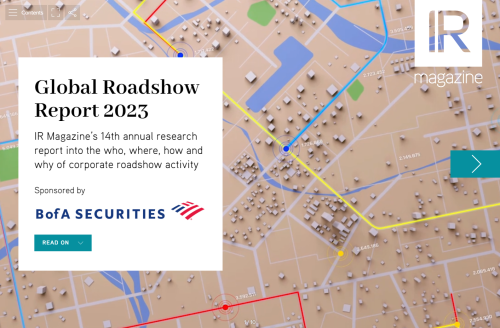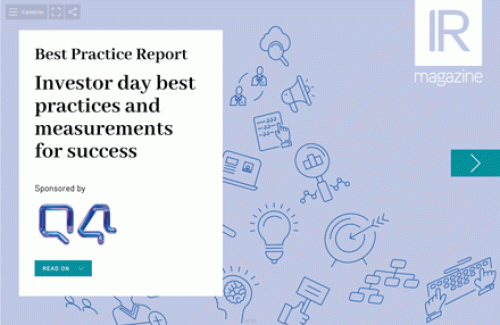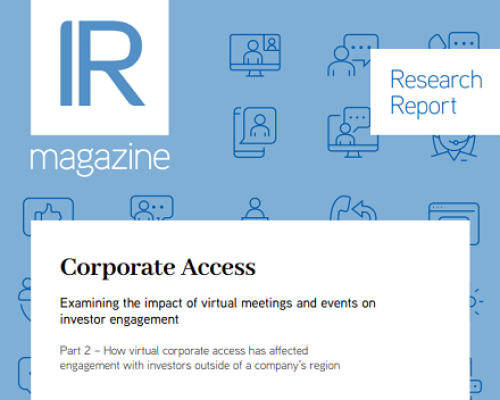Sponsored content
Hosted atop London’s iconic Gherkin building, in association with IR Magazine, Q4’s latest instalment in the Breakfast Briefing series put IRO peer conversations center stage. Almost 100 IROs from a variety of sectors, most coming from FTSE companies, gathered for breakfast and conversation on a sunny morning. Separated into five tables by theme, they were tasked with examining the top trends impacting their day-to-day work: shareholder activism, the impact of Mifid II, ESG investing, the use of alternative data, and M&A. For some compelling perspective on the role of IR today, here are a few of the critical takeaways from the IRO roundtables.
Shareholder activism
While shareholder activism has been a perennial feature of the IR landscape, it’s quickly becoming an everyday feature in the capital markets. Q4’s managing director for Europe, Amit Sanghvi, said ‘companies have to take proactive measures to identify activism early and be prepared with reactive measures, in case they get hit unexpectedly.’
Considering the hallmarks of a good activist response plan, Sanghvi pointed to the importance of using incoming investor inquiries and media reports to inform your IR messaging. ‘Noting the subject of discussions – as well as the tone of the conversation – can help determine whether any ‘influencers’ were disgruntled,’ he advised, explaining: ‘You need to take these points and funnel them back into further conversations with other investors. This is critical to preventing gaps in perception about how the business is run and how the investment community thinks it should be run.’
The shareholder activism table reported that IR and communications teams should foster good relations with key industry media contacts, so that they come to you first for a comment or any clarification (before a story breaks). ‘They might not hold the story back, but at least you’ll have the opportunity to share your perspective as the story hits the wires,’ Sanghvi explained.
A final best practice tip was to monitor news about your company and peers regularly. If a competitor is in the spotlight for a particular issue, you might be at risk of similar exposure. One way to stay ahead of activism is to leverage shareholder analysis, as well as artificial intelligence, to monitor your shareholder base on a regular basis. Watching for any atypical trading of your firm’s stock can alert you to activist situations brewing.
Mifid II and corporate access
Most IROs in the room agreed that since the Mifid II legislation had gone into effect, they’ve seen an increase in direct access from their investment communities. One reported that two US holders had contacted the firm directly, rather than via a broker, and that both holders now occupy a top 20 spot on their shareholder register. While a few IROs said they still rely heavily on broker partnerships, everyone agreed that direct contact from the buy side through the IR website was a growing trend. Making your contact details clearly visible on the IR website is key.
On the topic of corporate access and conferences, Michael Snell, Q4’s investor relations co-ordinator, asserted that his IRO table had universally recorded a drop in available investor events. Ironically, the overall consensus was that this could potentially be viewed as a positive development, as broker-organized events have traditionally attracted repeat visits from the same investors. ‘If you find yourself having the same meetings with the same managers, at multiple events at short intervals, your time might be better spent on other targeting activities,’ Snell explained. ‘The true value of conference events is when they attract new investors and relationships.’
The IROs around Snell’s table reported that ‘the quality of sell-side research had dropped’, which was likely the result of junior analysts covering a large number of companies. But with increased buy-side traffic on IR websites and the lack of availability of usable research, an ‘easy win’ is ‘making raw data about your company easily available to the buy side for download and use in their models.’
ESG outreach
Steven Wade, IR Magazine’s conference producer, pointed to a core piece of advice from the ESG roundtable: showcase your ESG policies on the IR website – which should also ‘result in reduced inbound queries.’ And in response to the room’s overall frustration around catering to rating agencies, the recommendation was to leverage Rate the Raters, to ‘identify, target and concentrate on the ratings agencies your investors care about the most.’
A final tip from a neighboring table was to include a corporate and buy-side ESG representative in one-to-one investor meetings, instead of delegating them to separate meetings. ‘Spending too much time on sustainability issues, outside of the context of your firm’s regular goals and operations, can be too abstract and potentially harmful,’ said one IRO.
Overall, the consensus was that ESG ‘would be bigger than ever, over the next two to three years.’ And in light of the Extinction Rebellion protests taking place around the world, Wade concluded, ‘IR teams should ask themselves: what does Greta (Thunberg) want?’’
Alternative and Big Data
Examining how investors use alternative and big data, session leader Sam Cockerill, head of Europe sales at Q4, said it would serve IROs well to know how investors and analysts are looking at your data – particularly when it comes to the message contained in a trading update. ‘Transcript readers can pick up on sentiment conveyed by your word choice, so changing your wording rather than any key takeaways can make a big difference,’ he explained.
In fact, one banking firm in attendance said it regularly analyzes its own earnings transcripts by AI-powered software. Its aim is to be proactive about uncovering overused words or any other content that could unintentionally generate negative sentiment.
M&A
Nicola Rogers, IR manager for Tullow Oil, said her table-mates showed a breadth of involvement in corporate actions, depending on the company’s culture and how much the IR function was valued. ‘IR needs a seat at the table on a big transaction, so that investor views are integrated into the decision-making process,’ she explained.
Though there are strict rules in the run-up to a big deal, Rogers said messaging should convey a broad ‘openness to growth’, so that any inorganic activity doesn’t come as a complete surprise. Consistency in messaging is also key: a sudden change in tone can give the market an untimely tip-off on behind-closed-door activities.
The M&A roundtable found that as M&A news goes public, IROs also need to be prepared with the key metrics that are important to their shareholders and weave them into an effective sales pitch. It’s critical to relate the inorganic activity back to the company strategy, as a reminder that both are linked. ‘Ultimately, the message should be focused on how the deal will generate shareholder value,’ Rogers said.
The event wrapped up on a final note that the usual touchpoints of investor outreach are crucial. These include Q&As and conference calls, as well as access to data on your market peers, the general market backdrop and the success of similar transactions. IROs should quickly communicate the transaction and the evolved strategy for the new combined company. After all, good IR is about getting ahead of market chatter and setting expectations yourself.
Interested in Q4’s European Breakfast series? Read about past events in Stockholm and London.










